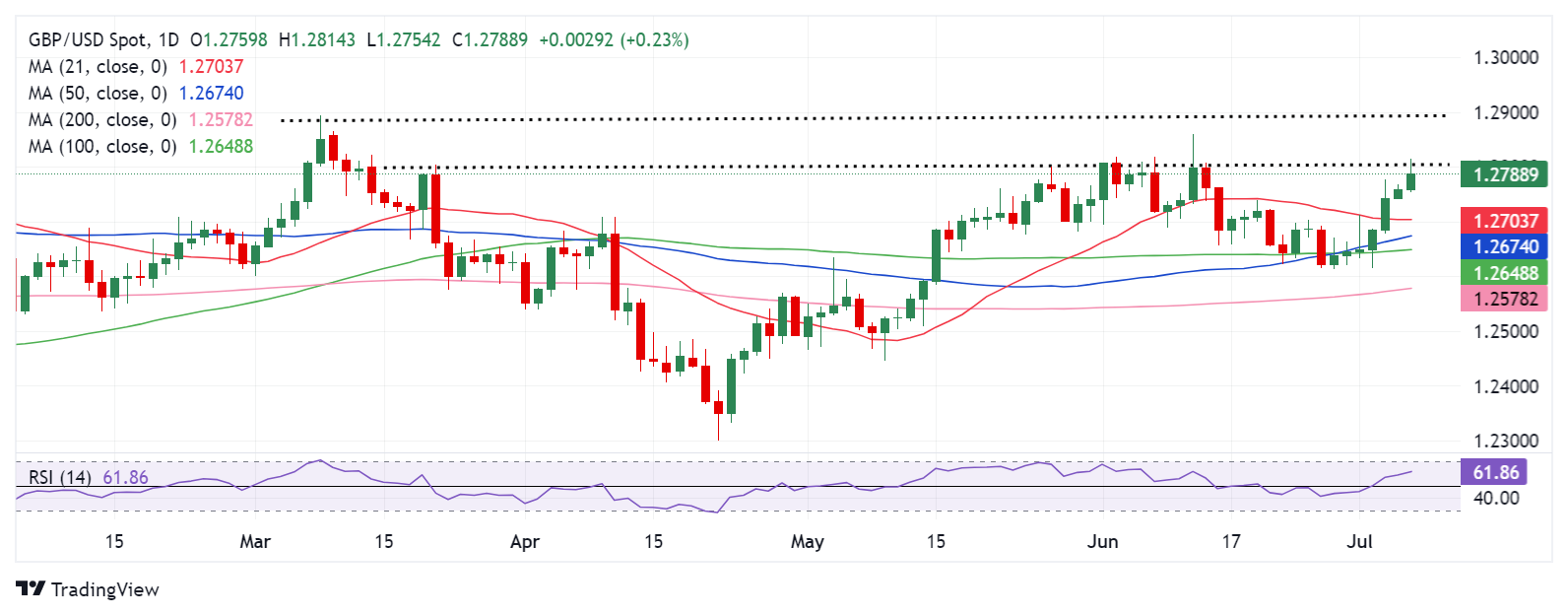- The Pound Sterling extended the previous week’s rebound against the US Dollar.
- GBP/USD looks forward to the US CPI inflation data for the next push higher.
- The 1.2900 level and the bullish daily RSI could continue to lure Pound Sterling buyers.
The Pound Sterling (GBP) built on the previous week’s rebound against the US Dollar (USD), driving the GBP/USD pair back toward 1.2800, the highest level in nearly three weeks.
Pound Sterling capitalizes on US Dollar pullback
GBP/USD staged a solid comeback from a six-week trough to reach multi-week highs, mainly due to a steep correction in the US Dollar across its main currency rivals.
Dovish remarks from Federal Reserve (Fed) Chairman Jerome Powell, during his speech at the European Central Bank (ECB) Forum on Central Banking in Sintra, spelled doom for the Greenback. The pain was exacerbated by a bunch of disappointing US business activity and employment data.
Fed Chair Jerome Powell acknowledged progress in disinflation on Tuesday. The ADP data from Wednesday showed that the US private sector employment rose by 150,000 in June, following the 157,000 increase (revised from 152,000) recorded in May.
Meanwhile, the number of Americans filing first-time unemployment claims rose 4,000 last week to 238,000, according to Labor Department data released on Wednesday. The figure was slightly higher than the estimate of 235,000. Finally, US ISM Services PMI fell into contraction territory in June, arriving at 48.8 vs. May’s 53.8 and the expected 52.5 print.
On Friday, the all-important US labor market report, including the Nonfarm Payrolls (NFP), also failed to lift the mood around the US Dollar. Data published by the Labor Department showed that the headline NFP increased by 206,000 in June, beating the market forecast for a 190,000 gain. Despite strong June figures, April and May readings were significantly revised down by a combined 111,000. Average hourly earnings rose 3.9% year-on-year, as expected, registering its lowest since the second quarter of 2021.
Markets are currently seeing a 74% chance of a cut in September, according to the CME FedWatch tool, and pricing in potentially two rate cuts this year. At the beginning of the week, the September rate cut probability stood at around 64%.
British Pound PRICE Last 7 days
The table below shows the percentage change of British Pound (GBP) against listed major currencies last 7 days. British Pound was the strongest against the Japanese Yen.
| USD | EUR | GBP | JPY | CAD | AUD | NZD | CHF | |
|---|---|---|---|---|---|---|---|---|
| USD | -1.12% | -1.25% | 0.11% | -0.46% | -1.31% | -0.76% | 0.00% | |
| EUR | 1.12% | -0.14% | 1.24% | 0.66% | -0.20% | 0.36% | 1.13% | |
| GBP | 1.25% | 0.14% | 1.36% | 0.79% | -0.06% | 0.48% | 1.22% | |
| JPY | -0.11% | -1.24% | -1.36% | -0.59% | -1.42% | -0.88% | -0.13% | |
| CAD | 0.46% | -0.66% | -0.79% | 0.59% | -0.86% | -0.31% | 0.41% | |
| AUD | 1.31% | 0.20% | 0.06% | 1.42% | 0.86% | 0.56% | 1.29% | |
| NZD | 0.76% | -0.36% | -0.48% | 0.88% | 0.31% | -0.56% | 0.72% | |
| CHF | -0.00% | -1.13% | -1.22% | 0.13% | -0.41% | -1.29% | -0.72% |
The heat map shows percentage changes of major currencies against each other. The base currency is picked from the left column, while the quote currency is picked from the top row. For example, if you pick the British Pound from the left column and move along the horizontal line to the US Dollar, the percentage change displayed in the box will represent GBP (base)/USD (quote).
On the UK side of the equation, the Pound Sterling held firmer throughout the week, having already priced in a landslide win for the opposition Labour Party. Finally, early Friday, the results of the vote count showed a sweeping victory for Labour, securing above the required 326 seats needed for a working majority in the 650-seat strong House of Commons.
Outgoing British Prime Minister, Rishi Sunak, conceded defeat in the national election and congratulated the Labour Party leader, Keir Starmer. Prime Minister-elect Keir Starmer in his victory speech said “today we start the next chapter -- begin the work of change, the mission of national renewal and start to rebuild our country.”
The Pound Sterling paid little heed to the exit polls and the outcome of the UK 2024 general elections, as it would take some time for markets to assess the implications of a Labour win for the Bank of England’s (BoE) interest-rate cut outlook and domestic currency performance.
Week ahead: US CPI inflation data in focus
After an action-packed week, the start of the upcoming week appears relatively quiet before the calendar fills up with top-tier data in the latter half.
Monday is devoid of important data releases from both sides of the Atlantic but BoE policymaker Jonathon Haskel’s speech will grab some attention ahead of Tuesday’s BoE Quarterly Bulletin and Fed Chair Powell’s testimony about the Semi-Annual Monetary Policy Report before the Senate Banking Committee in Washington.
Powell’s words once again could trigger a fresh directional move in the US Dollar, significantly impacting the Cable.
Yet another light docket on Wednesday, with BoE Chief Economist Huw Pill taking up the rostrum. It will round 2 of Powell’s testimony, this time before the House Financial Services Committee.
On Thursday, all eyes will be on the US Consumer Price Index (CPI) release for June, which will provide fresh hints on the timing of the Fed’s first rate cut this year. Ahead of that, the UK monthly Gross Domestic Product (GDP) could entertain Pound Sterling traders.
Friday will feature the US Producer Price Index (PPI) report, followed by the preliminary University of Michigan (UoM) Consumer Sentiment and Inflation Expectations data, winding down a mediocre week.
Apart from the economic statistics, traders will continue to analyze the speeches from the Fed policymakers and their implications on the path forward on interest rates.
GBP/USD: Technical Outlook
Pound Sterling bounced off strong support near 1.2610 and took out all the major daily simple moving average (SMA) resistances on its road to recovery against the US Dollar.
The 14-day Relative Strength Index (RSI) recaptured 50, currently near 60, suggesting a shift in risks to the upside.
These bullish technical indicators suggest that the path of least resistance for the GBP/USD pair appears north.
The primary resistance is now aligned at the intermittent highs near 1.2815.
A sustained move above the key 1.2815 upside hurdle could fuel a fresh advance toward the March high of 1.2894. The last line of defense for Pound sellers is seen at the 1.2950 psychological level.
Conversely, a failure to find a foothold above the 1.2800-1.2815 supply zone could reinforce selling interests.
Pound Sterling sellers will then target the 1.2700 level once again, the confluence of the 21-day SMA and the round figure.
The 50-day SMA at 1.2673 and the 100-day SMA at 1.2648 could be the next support levels on sustained declines.
Further down, the abovementioned static support near 1.2610 will come into play once again. If that gives way, then a test of the 200-day SMA at 1.2578 will be inevitable.
Information on these pages contains forward-looking statements that involve risks and uncertainties. Markets and instruments profiled on this page are for informational purposes only and should not in any way come across as a recommendation to buy or sell in these assets. You should do your own thorough research before making any investment decisions. FXStreet does not in any way guarantee that this information is free from mistakes, errors, or material misstatements. It also does not guarantee that this information is of a timely nature. Investing in Open Markets involves a great deal of risk, including the loss of all or a portion of your investment, as well as emotional distress. All risks, losses and costs associated with investing, including total loss of principal, are your responsibility. The views and opinions expressed in this article are those of the authors and do not necessarily reflect the official policy or position of FXStreet nor its advertisers. The author will not be held responsible for information that is found at the end of links posted on this page.
If not otherwise explicitly mentioned in the body of the article, at the time of writing, the author has no position in any stock mentioned in this article and no business relationship with any company mentioned. The author has not received compensation for writing this article, other than from FXStreet.
FXStreet and the author do not provide personalized recommendations. The author makes no representations as to the accuracy, completeness, or suitability of this information. FXStreet and the author will not be liable for any errors, omissions or any losses, injuries or damages arising from this information and its display or use. Errors and omissions excepted.
The author and FXStreet are not registered investment advisors and nothing in this article is intended to be investment advice.
Recommended Content
Editors’ Picks

EUR/USD holds lower ground below 1.0300 as traders await US NFP
EUR/USD holds lower ground below 1.0300 in European trading hours on Friday. Concerns over US President-elect Trump's policies and hawkish Fed expectations favor the US Dollar ahead of the critical US Nonfarm Payrolls data release.

GBP/USD falls back below 1.2300, US NFP eyed
GBP/USD is falling back below 1.2300 in the European morning on Friday, failing to sustain the rebound. The pair remains vulnerable amid persistent US Dollat strength and the UK bond market turmoil. The focus now shifts to the US labor market data for fresh trading directives.

Gold price sticks to intraday gains near multi-week top; US NFP in focus
Gold price attracts buyers for the fourth straight day on Friday amid some haven flows. The Fed’s hawkish stance, elevated US bond yields and a bullish USD should cap gains. Traders might also opt to wait for the release of the key US NFP report later this Friday.

Nonfarm Payrolls forecast: US December job gains set to decline sharply from November
US Nonfarm Payrolls are expected to rise by 160K in December after jumping by 227K in November. US jobs data is set to rock the US Dollar after hawkish Fed Minutes published on Wednesday.

How to trade NFP, one of the most volatile events Premium
NFP is the acronym for Nonfarm Payrolls, arguably the most important economic data release in the world. The indicator, which provides a comprehensive snapshot of the health of the US labor market, is typically published on the first Friday of each month.

Best Forex Brokers with Low Spreads
VERIFIED Low spreads are crucial for reducing trading costs. Explore top Forex brokers offering competitive spreads and high leverage. Compare options for EUR/USD, GBP/USD, USD/JPY, and Gold.
